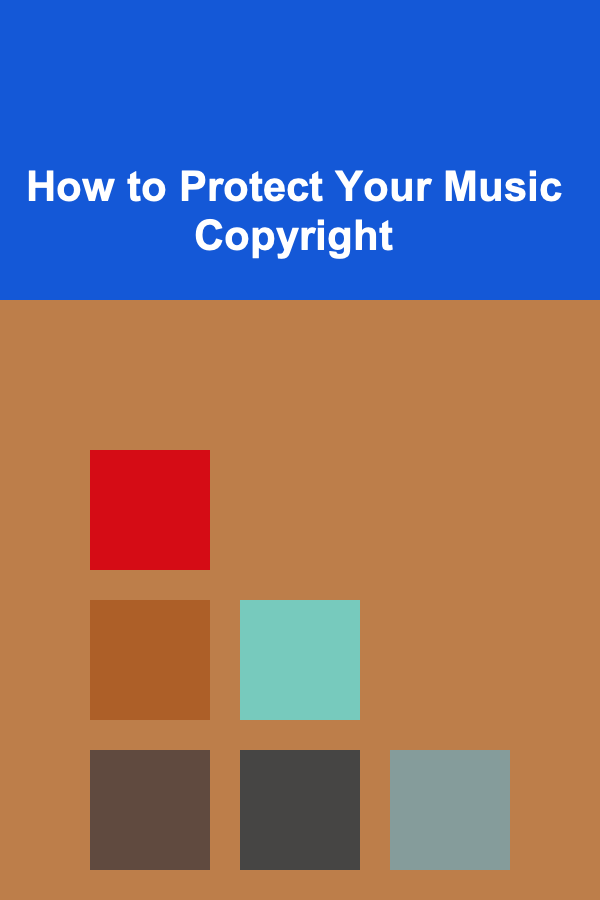
How to Protect Your Music Copyright
ebook include PDF & Audio bundle (Micro Guide)
$12.99$8.99
Limited Time Offer! Order within the next:

In the modern age, where digital technology has made it easier to create, share, and consume music, protecting your music copyright has never been more important. Whether you're an independent artist or a professional musician, understanding how to safeguard your creative work is essential. Without proper copyright protection, your music is vulnerable to unauthorized use, theft, and exploitation. In this article, we will delve deep into the various ways you can protect your music copyright, covering legal, technical, and practical strategies to secure your work.
Understanding Music Copyright
Before diving into how to protect your music copyright, it's important to understand what copyright is and what it covers. Copyright is a legal concept that grants the creator of an original work exclusive rights to its use and distribution. In the case of music, copyright protects both the composition (the melody, lyrics, and arrangement) and the sound recording (the actual recording of the music).
In most countries, music copyright is automatically granted as soon as a song is created and fixed in a tangible form (e.g., written down, recorded, etc.). However, while copyright is automatic, formal registration offers additional legal protections and benefits, particularly in case of disputes.
What Does Music Copyright Protect?
- Musical Composition: This includes the melody, harmony, rhythm, and lyrics of the song. It's the song's underlying structure.
- Sound Recording: This refers to the actual recording of the performance of the composition, whether it's a studio recording, live performance, or demo.
- Arrangements and Orchestrations: Any alterations or additions to a song's structure, such as orchestral arrangements or remixes, are also protected under copyright law.
Understanding what is and isn't covered by copyright will help you know how to protect your intellectual property effectively.
Register Your Music with a Copyright Office
Although copyright protection is automatic once your music is created and fixed in a tangible form, registering your music with a copyright office offers several advantages. By registering your copyright, you establish a public record of your ownership and gain access to certain legal benefits.
Why Register Your Music?
- Legal Protection: In the event of an infringement, having your music registered provides strong evidence of your ownership, which can make a legal case easier to win.
- Eligibility for Statutory Damages: If you've registered your music before an infringement occurs, you can claim statutory damages (pre-set damages defined by law) rather than actual damages, which may be harder to prove.
- International Protection: Many countries are part of international copyright treaties (like the Berne Convention), which means that registering your music in one country can help protect it in others as well.
How to Register Your Music
- United States: In the U.S., you can register your music through the U.S. Copyright Office website. The process involves completing an online form, paying a fee, and submitting a copy of the music.
- Other Countries: Many other countries have their own copyright offices, such as the UK's Intellectual Property Office or the Australian Copyright Council. The process may vary slightly depending on the country, but the core steps are generally similar.
Keep in Mind
- Copyright Duration: Copyright for music typically lasts for the life of the author plus 70 years in many countries. However, certain rules may apply to works created by corporations or for hire.
- Register Early: For maximum legal protection, register your music as soon as you complete your work.
Use Watermarking and Digital Rights Management (DRM)
In the digital age, music is often distributed and consumed online. To prevent unauthorized use or distribution of your music, you can employ digital protection methods like watermarking and DRM.
Digital Watermarking
Digital watermarking involves embedding an imperceptible code within the music file that identifies you as the owner. This watermark can be used to track the music's origin and ownership.
- Advantages: Watermarking is difficult to remove and can be used to trace illegal copies of your music.
- How to Implement: There are various services available to watermark your music files. These services insert a unique digital signature into the audio file without affecting sound quality. Companies like Digimarc provide these services for both music and other media.
Digital Rights Management (DRM)
DRM refers to technologies that control access to your music files and prevent unauthorized sharing, copying, or distribution.
- Types of DRM: DRM can include password protection, limiting the number of devices that can access the music, or restricting the ability to copy or transfer the music.
- How to Use DRM: Many music distributors and streaming platforms, such as Spotify and Apple Music, use DRM to protect the music uploaded by artists. If you distribute your music through these platforms, DRM protection is typically included.
While DRM is not foolproof, it can act as a deterrent to unauthorized distribution of your music.
Use Music Licensing Agreements
Licensing agreements allow you to grant permission for others to use your music under specific conditions. A well-drafted licensing agreement can help ensure that you retain control over how your music is used and that you receive fair compensation.
Types of Music Licenses
- Synchronization Licenses: If someone wants to use your music in a film, TV show, commercial, or video game, they will need a sync license. This type of license allows them to synchronize your music with visual media.
- Mechanical Licenses: This type of license is required when your music is reproduced, such as when it is pressed onto CDs, vinyl records, or distributed digitally.
- Public Performance Licenses: If your music is going to be played publicly (in a club, on the radio, at a concert, etc.), you need to grant a public performance license.
- Sample Clearances: If you are allowing someone to sample your music in their work, you'll need to grant them a sample clearance license.
Drafting a Licensing Agreement
When entering into a licensing agreement, make sure it clearly outlines:
- The scope of use (where, when, and how the music can be used)
- The payment structure (e.g., a flat fee, royalty, or percentage of revenue)
- The duration of the license
- Any limitations or conditions, such as territorial restrictions
By using proper licensing agreements, you can ensure that your music is used as you intend and that you are compensated fairly.
Monitor and Enforce Your Copyright
Once your music is copyrighted, it's your responsibility to monitor its use and enforce your rights if necessary. Monitoring the use of your music is especially important in the digital era, where unauthorized copies can be spread widely across the internet.
How to Monitor Your Music
- Online Search Tools: Use tools like Google Alerts to monitor mentions of your music online. You can set up alerts for song titles or your artist name to keep track of where your music is being used.
- Copyright Detection Services: Some companies specialize in helping artists track the use of their copyrighted works on the internet. Services like TuneCore or Audiam can help detect unlicensed uses of your music across platforms like YouTube.
- Social Media and Streaming Platforms: Keep an eye on platforms like YouTube, SoundCloud, and Instagram, as these are common places for people to share and distribute music. Many of these platforms offer content ID systems that help detect and manage copyright violations.
Enforcing Your Rights
If you find that your music is being used without your permission, you can take several steps:
- Send a Takedown Notice: Platforms like YouTube, SoundCloud, and Instagram have procedures for submitting Digital Millennium Copyright Act (DMCA) takedown notices to remove unauthorized content.
- Contact the Infringer: In some cases, it may be more effective to reach out directly to the person or organization using your music without permission. A polite but firm letter or email outlining your rights may encourage them to cease using your work.
- Legal Action: If the infringement is serious or ongoing, you may need to consult with a copyright attorney and pursue legal action. This can include filing a lawsuit for damages or seeking an injunction to stop further infringement.
Join a Performing Rights Organization (PRO)
A Performing Rights Organization (PRO) is an organization that helps artists collect royalties when their music is performed publicly, whether that's on the radio, in a nightclub, or at a concert.
Why Join a PRO?
- Collect Royalties: PROs track and collect royalties on behalf of musicians when their music is broadcast, performed live, or played in public spaces.
- Global Reach: PROs often have international agreements with other PROs around the world, helping you collect royalties globally.
- Protection Against Infringement: PROs can assist in detecting unauthorized uses of your music and take action on your behalf.
Popular PROs
- ASCAP (American Society of Composers, Authors, and Publishers)
- BMI (Broadcast Music, Inc.)
- SESAC (Society of European Stage Authors and Composers)
- PRS for Music (UK)
- SOCAN (Canada)
By joining a PRO, you ensure that your music is being properly tracked and that you're receiving royalties from public performances and broadcasts.
Conclusion
Protecting your music copyright is not a one-time task; it's an ongoing process that requires vigilance, proper documentation, and the use of legal and technical tools. From registering your music with a copyright office to utilizing watermarking, DRM, and licensing agreements, there are many ways to ensure that your creative work is protected. By actively monitoring and enforcing your rights, you can prevent unauthorized use and ensure that you receive the credit and compensation you deserve.
In a world where music can be easily shared and replicated, taking steps to safeguard your intellectual property is essential for your career as an artist. Whether you're just starting or are already established, implementing these strategies will help you maintain control over your music and secure your place in the music industry.
Reading More From Our Other Websites
- [Personal Care Tips 101] How to Use Cuticle Oil for Anti-Aging Benefits
- [Home Party Planning 101] How to Plan a Holiday Party at Home: Tips for a Festive Celebration
- [Home Storage Solution 101] How to Build DIY Storage Solutions for Every Room in Your Home
- [Personal Finance Management 101] How to Manage Your Finances as a Freelancer or Gig Worker
- [Organization Tip 101] How to Choose the Right Storage Solutions for Your Office
- [Metal Stamping Tip 101] Avoiding Common Pitfalls: Best Practices for Maintaining Consistency in High‑Volume Metal Stamping Operations
- [Home Renovating 101] How to Negotiate Prices with Home Improvement Suppliers
- [Home Lighting 101] How to Create Professional Studio-Quality Lighting for Makeup Application on a Budget
- [Home Maintenance 101] How to Keep Your Home's Fireplace in Working Order
- [Home Budget 101] How to Budget for Pet Adoption and Ensure a Smooth Transition

How Cutting Down on Alcohol and Tobacco Expenses Can Improve Your Budget
Read More
How to Track Your Home Spending with Apps
Read More
How to Use Smart Shelving to Save Space in Any Room
Read More
How to Use Texture in Home Staging to Add Depth
Read More
How to Plan a Snowboarding Trip for Adaptive Athletes
Read More
10 Tips for Ethical Handling of Sensitive Historical Materials
Read MoreOther Products

How Cutting Down on Alcohol and Tobacco Expenses Can Improve Your Budget
Read More
How to Track Your Home Spending with Apps
Read More
How to Use Smart Shelving to Save Space in Any Room
Read More
How to Use Texture in Home Staging to Add Depth
Read More
How to Plan a Snowboarding Trip for Adaptive Athletes
Read More